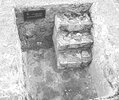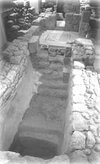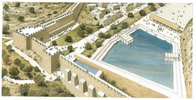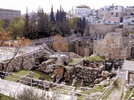Phil D.
ὁ βαπτιστὴς
This thread was prompted by something that was posited in another baptism thread, where I am naturally not allowed to respond, but to which I still wanted to respond…naturally…
_____________________________
Historically, skepticism that the 3000 converts at Pentecost (Acts 2:38, 41) could have been baptized by immersion in a single day has certainly been one of the most prominent features in arguments that immersion wasn’t always (or typically, or ever) used in apostolic times. In fact, this is the inaugural claim among any of such a nature that I have found. The earliest occurrence of it (again, that I have found) comes from c.1250 AD, as advanced by the medieval English theologian William of Melitona (d.1257), an eminent professor at the Catholic universities in both Paris and Cambridge.[1] The supposition was then taken up by some of his most prominent students at the Parisian Sorbonne, such as Thomas Aquinas and Bonaventure (in their doctoral theses on Lombard’s Sentences, both written in 1256 [2]). Notably, the instance of the 3000 persons was also the lone example of non-immersion in the New Testament originally proposed by any of these men, and immersion was still seen by them all as the normative and preferred mode for baptism. Such is also the first claim made by a Protestant with regard to apostolic non-immersion that I have found (1546). (Nicholas Thompson, ed., Martin Bucer: Opera Latina, (Leiden/Boston: Brill, 2014), 6:101) Ultimately, the idea that the 3000 couldn’t have been immersed was codified in the Roman Catholic Church by the Council of Trent [3], as well as perpetuated in various Protestant churches [4]. Clearly, the objection has quite a historical provenance.
The reasons for the conceived impossibility latent in these historical arguments seem to be some of the same difficulties as suggested in the other thread (I’m not picking on you Ed, honest..!).
I agree that the narrative in Acts implies that the baptisms were performed immediately, and as such on that very same day (although I have seen a fair number of even non-immersionist commentators conclude that the text does not demand such an understanding). Yet some anachronistic ideas that evidently play a considerable role in the overall argument might be pointed out.
First is the manner of religious immersion that would most likely have been used. There is a general consensus among scholars that in apostolic times – and this is demonstrably the case in descriptions of baptism in the early patristic church - immersion would have simply been performed by an administrator placing their right hand on the recipient’s head, while they lowered themselves into the water [5]. Thus, the method often used by modern immersionists, in which the minister cradles the upper part of the candidate’s body, horizontally lowers them into the water, and then lifts them out again [6] - and the extended time factor this involves - is probably not a valid factor with respect to considering the Pentecostal baptisms. Obviously, the early method also required relatively little physical exertion on the part of the administrator. A few patristic descriptions indicate that in some cases the administrator would even stand outside, but immediately adjacent to the font, while reaching his hand over the edge to perform the baptism.
Second, it is not necessary, or probable, to suppose that the same testimonial or ceremonial aspects that may accompany some modern Baptist baptisms were part of the apostolic rite. Moreover, regardless of whether immersion, pouring, or sprinkling are used, any basic ceremonial component of proper baptism would seem to require about the same amount of time, making the overall time necessary a relative non-factor when evaluating the three modal prospects (reasonably assuming that in all cases recipients would have received individual attention).
A third and related fourth supposed difficulty sometimes expounded, is that there would have been a lack of sufficient water or facilities in desert-bound ancient Jerusalem. These too are inaccurate and anachronistic perceptions, decidedly refuted by actual archeological records. First-century Jerusalem had a most impressive water supply and infrastructure [7], as well as numerous facilities that were used for religious immersions, both public and private [8].
In light of all these things, I would propose a different calculus for determining the time necessary to baptize the 3000 people by immersion at Pentecost. My suggestion is based on the 12 Apostles being the lone administrators, even though some commentators (even among the Reformed [9]) suggest or allow that some or all of the 120 men in Acts 1:15 may have also been involved in such an undertaking. I will also use what I believe is an overly ample allowance of 30 seconds for each individual baptism.
There are in fact other historical instances where mass baptisms by immersion have been performed in a single day. On the Easter Vigil in 404 AD, Chrysostom, assisted by a handful of his presbyters, baptized 3000 catechumens, despite the service being twice interrupted by marauders sent in by Chrysostom's vile enemies [10]. In 1878, a team of four Australian missionaries serving in India, and working in shifts of two, baptized over 2,200 converts Baptist style, in about 9 hours [11].
In the end, it seems fair to conclude that objections to the idea that the 3000 converts at Pentecost could have been baptized by immersion, ...well, don't hold water... While I can understand and excuse some earlier dissenters, the same leniency is harder to extend to more contemporary folks who have ready access to much more historical information.
[1] Caelestinus Piana, ed., Guillelmi de Militona, Quaestiones de Sacramentis, (Quaracchi, Florentiae: ex Typograpia Collegii S.Bonaventurae, 1961), 1:333
[2] Stanislas E. Fretté, Pauli Maré, eds., Doctoris Angelici Divi Thomae Aquinatis...Opera Omnia, (Parisiis: Ludovicum Vivés, Bibliopolam Editorem, 1873), 10:78; A. C. Peltier, ed., Cardinalis S. Bonaventura, Opera Omnia, (Parisiis: L. Vives, 1866), 5:317
[3] Catechismus, ex decreto Concilii Tridentini, ad parochos, (Romae: in aedibus Populi Romani, apud Paulum Manutium, 1566), 186; In this instance it was further asserted that Peter had performed all of the baptisms himself.
[4] Perhaps the most authoritative example of this is the Westminster Confession of Faith, where Acts 2:41 is one of five scripture proofs cited in support of non-immersion (WCF 28.3).
[5] See: Everett Ferguson, Baptism in the Early Church, (Grand Rapids: Eerdmans, 2009), passim; Edward Yarnald, The Awe-Inspiring Rites of Initiation: Baptismal Homilies of the 4th Century, (Slough: St. Paul Press, 1972), 180ff; H. F. Stander, J. P. Louw, Baptism in the Early Church, (Leeds: Reformation Today Trust, 2004), 37ff; Alphonse Mingana, Commentary of Theodore of Mopsuestia on the Lord’s Prayer, Baptism and the Eucharist, (Cambridge: W. Heffer & Sons, 1933), 180ff; Alistair Stewart-Sykes, Hippolytus; On the Apostolic Tradition, (New York: St. Vladimir’s Seminary Press, 2001), 111f; Ruggero Iorio, Battesimo e Battisteri, (Florence: Nardini, 1993), 108ff; Robin M. Jensen, Understanding Early Christian Art, (New York: Routledge, 2000), 77ff; et al.
[6] The earliest reference to this particular method of immersion I have found is in a description of baptism from Duns Scotus – so early 14th century; see his Parisian lectures on Lombard’s Sentences, 4:3.4; Reportata super quartum Sententiarum fratris Johannis Duns Scoti, [Parrhisiis: Ioanne Granion, 1518], no pagination – in loc. cit.)
[7] See: Sir Charles W. Wilson, Ordnance Survey of Jerusalem, (Jerusalem: Ariel Publishing House, 1865), 1:78ff; Alfred Edersheim, The Temple, Its Ministries and Services, (London: James Clark & Co., 1889), 2.55f; Emil Schürer, A History of the Jewish People in the Time of Jesus Christ, (New York: Charles Scribner’s Sons, 1891), 2:2.69; Abraham Holz, The Holy City: Jews on Jerusalem, [New York: W. W. Norton, 1970], 49; W. S. Lasor, “Jerusalem” - Geoffrey W. Bromiley, ed., The International Standard Bible Encyclopedia, Revised, (Grand Rapids: Wm. B. Eerdmans, 1979-88), 1002f; Bill Grasham, Archaeology and Christian Baptism; Restoration Quarterly, (Abilene: 2001), 43.2; Jonathan D. Lawrence, Washing in Water: Trajectories of Ritual Bathing in the Hebrew Bible and Second Temple Literature, (Atlanta: Society of Biblical Literature, 2006), 155ff
[8] See many of the same sources listed above. Josephus wrote of such provisions around the Temple Mount: “The inward parts had the largeness and form of a palace, it being parted into all kinds of rooms and convieniences such as courts, and places for bathing, and broad spaces for camps...” (The Wars of the Jews, 5.5.8)
(Fig. 1) A public mikveh from the 1st century AD—one of several dozen that have been excavated on the southern Temple Mount.
Fig. 2) A large private mikveh excavated in a 1st century Jerusalem residence.


(Fig. 3) A sketch depicting what a large house excavated in what was an affluent area of 1st century Jerusalem may have looked like. It contained two separate mikveh, probably to segregate men and women, along with a separate facility for hygienic bathing. The larger mikveh featured a side-by-side entrance and exit, to efficiently accommodate purificatory immersions on a large scale (walk-in, half-circle-around, walk-out). Another large house nearby has also been excavated, and was found to contain seven immersion pools.
.

(Fig. 4) The Pool of Shilocah (Siloam) was just recently discovered (2019) during excavations in the southern City of David. Broad steps surrounded the pool, which was fed by the water of the Gihon Spring (which still produces around 1,000,000 gallons of water daily), that flowed into Hezekiah’s Tunnel from the time of the First Temple. Due to its location along the ancient Jewish “Pilgrimage Road,” the emerging consensus is that it was used for some of the ritual immersions required for the tens of thousands of pilgrims who streamed into Jerusalem each year on the three pilgrimage festivals, Passover, Pentecost, and Booths, in order to be able to participate in Temple worship. Based on what the excavations have revealed, the depiction below shows what it may have looked like in the 1st century. There is also direct biblical indication that this pool was sometimes used in a ritual capacity (John 9:6-7).

(Fig. 5) The Bethesda Pool, where Jesus healed the paralytic man in the Gospel of John, is a complex site. It too appears to have served as a mikveh, or ritual bath (cf. John 5:2-4 NKJV). As the spot of one of Jesus’ miracles, the Bethesda Pool was built over in subsequent periods with chapels and churches that are still visible today.

[9] For example, the Westminster divine John Lightfoot; John Lightfoote, Commentary upon the Acts of the Apostles, chronicall and criticall..., (London: R.C. for Andrew Crooke, 1645), 25; also: Francis Turretin, Institutes of Elenctic Theology, 19.14.11
[10] As recorded by the eyewitness and Chrysostom's friend and disciple, Palladius of Galatia. (Da Vita S. Joannis Chrysostomi, 9; PG 47:33f)
[11] Baptism: Our Lord's Command, (Melbourne: Austral Publishing Co., 1913), 161
_____________________________
Historically, skepticism that the 3000 converts at Pentecost (Acts 2:38, 41) could have been baptized by immersion in a single day has certainly been one of the most prominent features in arguments that immersion wasn’t always (or typically, or ever) used in apostolic times. In fact, this is the inaugural claim among any of such a nature that I have found. The earliest occurrence of it (again, that I have found) comes from c.1250 AD, as advanced by the medieval English theologian William of Melitona (d.1257), an eminent professor at the Catholic universities in both Paris and Cambridge.[1] The supposition was then taken up by some of his most prominent students at the Parisian Sorbonne, such as Thomas Aquinas and Bonaventure (in their doctoral theses on Lombard’s Sentences, both written in 1256 [2]). Notably, the instance of the 3000 persons was also the lone example of non-immersion in the New Testament originally proposed by any of these men, and immersion was still seen by them all as the normative and preferred mode for baptism. Such is also the first claim made by a Protestant with regard to apostolic non-immersion that I have found (1546). (Nicholas Thompson, ed., Martin Bucer: Opera Latina, (Leiden/Boston: Brill, 2014), 6:101) Ultimately, the idea that the 3000 couldn’t have been immersed was codified in the Roman Catholic Church by the Council of Trent [3], as well as perpetuated in various Protestant churches [4]. Clearly, the objection has quite a historical provenance.
The reasons for the conceived impossibility latent in these historical arguments seem to be some of the same difficulties as suggested in the other thread (I’m not picking on you Ed, honest..!).
I have always taken vs. 41 that the baptisms were completed that day. My wife and I attended a pool baptism where seven people were baptized. The seven took about two hours. That's 17± minutes per person which included prayer, testimony, follow by the words and actions of the baptism. Granted, that time could be reduced, but reduced by how much? Maybe there were groups, even whole families dunked simultaneously. But, wouldn't anything faster, or more people at once would present a pretty weird and frenzied service we could hardly recognize. So how about 3 minutes average per person.
Here's the 3rd-grade math. NOTE: Days and Weeks, are based on a 40-hour/5-day week: 3,000 (people) X 3 (minutes) = 9,000 (minutes) = 150 (hours) = 18.75 (8-hour days) = 3.75 (5-day weeks). At 3 minutes apiece, this baptism would make this among the weirdest baptism ever.
I agree that the narrative in Acts implies that the baptisms were performed immediately, and as such on that very same day (although I have seen a fair number of even non-immersionist commentators conclude that the text does not demand such an understanding). Yet some anachronistic ideas that evidently play a considerable role in the overall argument might be pointed out.
First is the manner of religious immersion that would most likely have been used. There is a general consensus among scholars that in apostolic times – and this is demonstrably the case in descriptions of baptism in the early patristic church - immersion would have simply been performed by an administrator placing their right hand on the recipient’s head, while they lowered themselves into the water [5]. Thus, the method often used by modern immersionists, in which the minister cradles the upper part of the candidate’s body, horizontally lowers them into the water, and then lifts them out again [6] - and the extended time factor this involves - is probably not a valid factor with respect to considering the Pentecostal baptisms. Obviously, the early method also required relatively little physical exertion on the part of the administrator. A few patristic descriptions indicate that in some cases the administrator would even stand outside, but immediately adjacent to the font, while reaching his hand over the edge to perform the baptism.
Second, it is not necessary, or probable, to suppose that the same testimonial or ceremonial aspects that may accompany some modern Baptist baptisms were part of the apostolic rite. Moreover, regardless of whether immersion, pouring, or sprinkling are used, any basic ceremonial component of proper baptism would seem to require about the same amount of time, making the overall time necessary a relative non-factor when evaluating the three modal prospects (reasonably assuming that in all cases recipients would have received individual attention).
A third and related fourth supposed difficulty sometimes expounded, is that there would have been a lack of sufficient water or facilities in desert-bound ancient Jerusalem. These too are inaccurate and anachronistic perceptions, decidedly refuted by actual archeological records. First-century Jerusalem had a most impressive water supply and infrastructure [7], as well as numerous facilities that were used for religious immersions, both public and private [8].
In light of all these things, I would propose a different calculus for determining the time necessary to baptize the 3000 people by immersion at Pentecost. My suggestion is based on the 12 Apostles being the lone administrators, even though some commentators (even among the Reformed [9]) suggest or allow that some or all of the 120 men in Acts 1:15 may have also been involved in such an undertaking. I will also use what I believe is an overly ample allowance of 30 seconds for each individual baptism.
What if there were 3 rotations of 4 men each, which would then take a total of about 6 hours and 15 minutes (3000 ÷ 4 x 30 seconds). This in turn breaks down to each of the 12 perhaps baptizing for 3 shifts, each about 42 minutes in length, and with nearly 1-½ hour rests (or time for further evangelization) in between.
Such an enterprise certainly wouldn’t be unfeasible, let alone impossible (especially considering that four of the disciples had been professional fishermen...). This is of course only one of many possible scenarios, and if more people were involved in the process the workload could easily have been spread out even more.There are in fact other historical instances where mass baptisms by immersion have been performed in a single day. On the Easter Vigil in 404 AD, Chrysostom, assisted by a handful of his presbyters, baptized 3000 catechumens, despite the service being twice interrupted by marauders sent in by Chrysostom's vile enemies [10]. In 1878, a team of four Australian missionaries serving in India, and working in shifts of two, baptized over 2,200 converts Baptist style, in about 9 hours [11].
In the end, it seems fair to conclude that objections to the idea that the 3000 converts at Pentecost could have been baptized by immersion, ...well, don't hold water... While I can understand and excuse some earlier dissenters, the same leniency is harder to extend to more contemporary folks who have ready access to much more historical information.
[1] Caelestinus Piana, ed., Guillelmi de Militona, Quaestiones de Sacramentis, (Quaracchi, Florentiae: ex Typograpia Collegii S.Bonaventurae, 1961), 1:333
[2] Stanislas E. Fretté, Pauli Maré, eds., Doctoris Angelici Divi Thomae Aquinatis...Opera Omnia, (Parisiis: Ludovicum Vivés, Bibliopolam Editorem, 1873), 10:78; A. C. Peltier, ed., Cardinalis S. Bonaventura, Opera Omnia, (Parisiis: L. Vives, 1866), 5:317
[3] Catechismus, ex decreto Concilii Tridentini, ad parochos, (Romae: in aedibus Populi Romani, apud Paulum Manutium, 1566), 186; In this instance it was further asserted that Peter had performed all of the baptisms himself.
[4] Perhaps the most authoritative example of this is the Westminster Confession of Faith, where Acts 2:41 is one of five scripture proofs cited in support of non-immersion (WCF 28.3).
[5] See: Everett Ferguson, Baptism in the Early Church, (Grand Rapids: Eerdmans, 2009), passim; Edward Yarnald, The Awe-Inspiring Rites of Initiation: Baptismal Homilies of the 4th Century, (Slough: St. Paul Press, 1972), 180ff; H. F. Stander, J. P. Louw, Baptism in the Early Church, (Leeds: Reformation Today Trust, 2004), 37ff; Alphonse Mingana, Commentary of Theodore of Mopsuestia on the Lord’s Prayer, Baptism and the Eucharist, (Cambridge: W. Heffer & Sons, 1933), 180ff; Alistair Stewart-Sykes, Hippolytus; On the Apostolic Tradition, (New York: St. Vladimir’s Seminary Press, 2001), 111f; Ruggero Iorio, Battesimo e Battisteri, (Florence: Nardini, 1993), 108ff; Robin M. Jensen, Understanding Early Christian Art, (New York: Routledge, 2000), 77ff; et al.
[6] The earliest reference to this particular method of immersion I have found is in a description of baptism from Duns Scotus – so early 14th century; see his Parisian lectures on Lombard’s Sentences, 4:3.4; Reportata super quartum Sententiarum fratris Johannis Duns Scoti, [Parrhisiis: Ioanne Granion, 1518], no pagination – in loc. cit.)
[7] See: Sir Charles W. Wilson, Ordnance Survey of Jerusalem, (Jerusalem: Ariel Publishing House, 1865), 1:78ff; Alfred Edersheim, The Temple, Its Ministries and Services, (London: James Clark & Co., 1889), 2.55f; Emil Schürer, A History of the Jewish People in the Time of Jesus Christ, (New York: Charles Scribner’s Sons, 1891), 2:2.69; Abraham Holz, The Holy City: Jews on Jerusalem, [New York: W. W. Norton, 1970], 49; W. S. Lasor, “Jerusalem” - Geoffrey W. Bromiley, ed., The International Standard Bible Encyclopedia, Revised, (Grand Rapids: Wm. B. Eerdmans, 1979-88), 1002f; Bill Grasham, Archaeology and Christian Baptism; Restoration Quarterly, (Abilene: 2001), 43.2; Jonathan D. Lawrence, Washing in Water: Trajectories of Ritual Bathing in the Hebrew Bible and Second Temple Literature, (Atlanta: Society of Biblical Literature, 2006), 155ff
[8] See many of the same sources listed above. Josephus wrote of such provisions around the Temple Mount: “The inward parts had the largeness and form of a palace, it being parted into all kinds of rooms and convieniences such as courts, and places for bathing, and broad spaces for camps...” (The Wars of the Jews, 5.5.8)
(Fig. 1) A public mikveh from the 1st century AD—one of several dozen that have been excavated on the southern Temple Mount.
Fig. 2) A large private mikveh excavated in a 1st century Jerusalem residence.


(Fig. 3) A sketch depicting what a large house excavated in what was an affluent area of 1st century Jerusalem may have looked like. It contained two separate mikveh, probably to segregate men and women, along with a separate facility for hygienic bathing. The larger mikveh featured a side-by-side entrance and exit, to efficiently accommodate purificatory immersions on a large scale (walk-in, half-circle-around, walk-out). Another large house nearby has also been excavated, and was found to contain seven immersion pools.
.

(Fig. 4) The Pool of Shilocah (Siloam) was just recently discovered (2019) during excavations in the southern City of David. Broad steps surrounded the pool, which was fed by the water of the Gihon Spring (which still produces around 1,000,000 gallons of water daily), that flowed into Hezekiah’s Tunnel from the time of the First Temple. Due to its location along the ancient Jewish “Pilgrimage Road,” the emerging consensus is that it was used for some of the ritual immersions required for the tens of thousands of pilgrims who streamed into Jerusalem each year on the three pilgrimage festivals, Passover, Pentecost, and Booths, in order to be able to participate in Temple worship. Based on what the excavations have revealed, the depiction below shows what it may have looked like in the 1st century. There is also direct biblical indication that this pool was sometimes used in a ritual capacity (John 9:6-7).

(Fig. 5) The Bethesda Pool, where Jesus healed the paralytic man in the Gospel of John, is a complex site. It too appears to have served as a mikveh, or ritual bath (cf. John 5:2-4 NKJV). As the spot of one of Jesus’ miracles, the Bethesda Pool was built over in subsequent periods with chapels and churches that are still visible today.

[9] For example, the Westminster divine John Lightfoot; John Lightfoote, Commentary upon the Acts of the Apostles, chronicall and criticall..., (London: R.C. for Andrew Crooke, 1645), 25; also: Francis Turretin, Institutes of Elenctic Theology, 19.14.11
[10] As recorded by the eyewitness and Chrysostom's friend and disciple, Palladius of Galatia. (Da Vita S. Joannis Chrysostomi, 9; PG 47:33f)
[11] Baptism: Our Lord's Command, (Melbourne: Austral Publishing Co., 1913), 161
Last edited:


